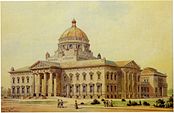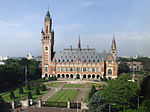- Architectural design competition
-
An architectural design competition is a special type of competition in which an organization or government body that plans to build a new building asks for architects to submit a proposed design for a building. The winning design is usually chosen by an independent panel of design professionals and stakeholders (such as government and local representatives). This procedure is often used to generate new ideas for the building design, to stimulate public debate, to generate publicity for the project and allow emerging designers the opportunity of gaining exposure. Architecture competitions are often used for public buildings in Denmark, Switzerland and Germany, while in France design competitions are compulsory for all public buildings exceeding a certain cost.[1]
Attaining the first prize in a competition is not a guarantee that the project will be completed. This is due to any number of local issues that can develop at the proposed construction site. The owner of the site must also be able to obtain financing for construction and often has the right to veto the winning design. The original 2002 World Trade Center Master Design Contest in New York City is a prime example of a highly publicized competition where only the basic elements of the winning design by Daniel Libeskind will appear in the finished project.
History
Architecture competitions have a more than 2,500-year-old history. The Acropolis in Athens was a result of an architectural competition, as were several cathedrals in the Middle Ages. In 1419 a competition was held to design the dome of the Florence Cathedral, which was won by Filippo Brunelleschi. Open competitions were held in the late 18th century in several countries including the United States, Great Britain, Ireland, France and Sweden.[2]
In 19th century England and Ireland there have been over 2,500 competitions in five decades, with 362 in London alone. The Institute of British Architects drafted a first set of rules in 1839, and a set of formal regulations in 1872. In the same period in the Netherlands an association for the advancement of architecture (Maatschappij tot Bevordering van de Bouwkunst) started organising conceptual competitions with the aim of stimulating architects' creativity.[3]
Competition for the design of the Peace Palace in The Hague, 1905
Entries (from left to right) by Otto Wagner, Franz Heinrich Schwechten, Hendrik Petrus Berlage and built design by Louis M. CordonnierCompetition types
There are a variety of competition types resulting from the combination of following options:[4]
- Open competitions (international, national or regional) or Limited / Selected competitions, depending on who is allowed to participate;
- Project competitions or Ideas competitions, depending on whether the aim is to build the project or to generate new ideas only;
- One stage or Two stage competitions, depending on the scale and complexity of the competition;
- Student design competitions.
Rules and guidelines
The rules of each competition are defined by the organiser, however these often follow the guidelines provided by the International Union of Architects,[5] respectively the relevant national or regional architecture organisation. Competition guidelines define roles, responsibilities, processes, and procedures within a competition[6] and provide guidance on possible competition types, eligibility criteria, jury composition, participation conditions, payments, prizes, publication of results and other aspects.[7][8]
Major international architectural design competitions
See also: List of Architectural design competitionsMost significant among architectural competitions are the ones which are internationally open, attract a large number of design submissions, and the winning design is built.
References
- ^ Jacques Cabanieu: Competitions and Architectural Excellence, in Places 9:2, MIT, 1994, retrieved 2009-09-25
- ^ 130 Years of Finnish architectural competitions, retrieved 2009-09-23
- ^ De Jong, Cees and Mattie, Erik: Architectural Competitions 1792-1949, Taschen, 1997, ISBN 3822885991
- ^ Australian Institute of Architects: Competition Guidelines, retrieved 2009-09-06
- ^ UIA competition guide, retrieved 2009-10-10
- ^ Canadian competition rules, retrieved 2009-10-10
- ^ Finish competition rules, retrieved 2009-10-10
- ^ Indian competition guidelines, retrieved 2009-10-10
Further reading
- De Jong, Cees and Mattie, Erik: Architectural Competitions 1792-1949, Taschen, 1997, ISBN 3822885991
External links
- Architectural Competition - Nordic Symposium
- CABE: Making Competitions Work
- Canadian Competitions Catalogue
- Wettbewerbe Aktuell, a German journal specialized in architectural competitions
- DesignCompetition.com, list of design competitions
Categories:- Architectural competitions
- Architectural design
Wikimedia Foundation. 2010.




